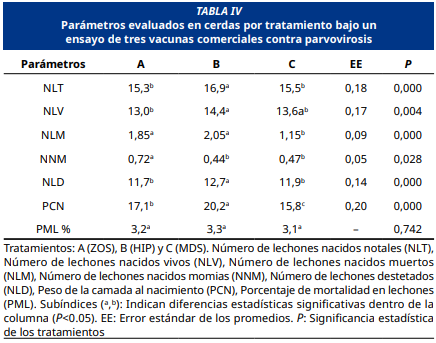Effect of three commercial vaccines against porcine parvovirus on antibody production and performance of Camborough sows
Abstract
This study was conducted on a commercial farm in Trujillo, Peru, to evaluate the effect of three vaccines against porcine parvovirus on antibody production and the productive and reproductive parameters of sows. A total of 375 multiparous Camborough sows were monitored and randomly assigned to three treatments corresponding to the vaccines: A (ZOS), B (HIP), and C (MDS). Sows selected were between their second and sixth parities, with good body condition, and similar productive and reproductive performance. Two blood samples were collected from each sow: the first, one day before vaccination, and the second, three weeks after the injection. Antibody titers were determined using ELISA. No significant statistical differences were observed in the antibody titers before vaccination (P>0.05). However, at 21 days post–vaccination, highly significant differences were found (P<0.01), with the HIP vaccine showing the highest antibody titers. Among the evaluated productive parameters, including the number of live–born, stillborn, and weaned piglets and litter birth weight, significant differences were detected in favor of the HIP vaccine (P<0.01). Additionally, the sows vaccinated with HIP had fewer mummified piglets (P<0.05). No significant differences (P>0.05) were observed among the treatments in terms of fertility, non–return, or farrowing rates. In conclusion, the commercial HIP vaccine significantly increased antibody titers, improved productive performance, and did not adversely affect reproductive parameters compared to the other two commercial vaccines in Camborough sows.
Downloads
References
Noguera M, Vela A, Christian K, Chevalier M, Goutebroze S, de Paz X, Kunze M, Rathkjen P, Schacht E, Morante–Garcia B. Effect if three comercial vaccines against porcine parvovirus 1 in pregnant gilts. Vaccine [Internet]. 2021; 39(29):3997–4005. doi: https://doi.org/gkd6c6 DOI: https://doi.org/10.1016/j.vaccine.2021.05.042
Garcia–Morante B, Noguera M, Klocke S, Sommer K, Bridger P. Duration of immunity against heterologous porcine parvovirus 1 challenge in gilts immunized with a novel subunit vaccine based on the viral protein 2. BMC Vet. Res. [Internet]. 2020; 16(1):184. doi: https://doi.org/p8vz DOI: https://doi.org/10.1186/s12917-020-02394-4
Bachmann PA, Sheffy BE, Vauhan JT. Experimental in utero infection of fetal pigs with a porcine parvovirus. Infect. Immun. [Internet]. 1975; 12(3):455–460. doi: https://doi.org/p8v2 DOI: https://doi.org/10.1128/iai.12.3.455-460.1975
Barrs VR. Feline Panleukopenia: A re–emergent disease. Vet. Clin. North Am. Small Anim. Pract. [Internet]. 2019; 49(4):651–670. doi: https://doi.org/gqvjdm DOI: https://doi.org/10.1016/j.cvsm.2019.02.006
Rico S, Molina S, Pabón F. Detección y aislamiento del Parvovirus porcino en Medellín, Colombia. Rev. Colomb. Cienc. Pecu. [Internet]. 2003 [consultado 22 May. 2025]; 16(1):40–45. Disponible en: https://goo.su/iAmkf DOI: https://doi.org/10.17533/udea.rccp.323851
Luevano–Adame J, Sarmiento R, Mendoza S. Valoración de la vacunación contra parvovirus porcino en granjas afectadas previamente a diarrea epidémica porcina. [tesis de maestría en Internet]. Trujillo, México: Universidad Nacional Autónoma de México. 2020 [consultado 10 Abr. 2025]; 102 p. Disponible en: https://goo.su/Btltzx
Rivera–Benítez J, De la Luz–Armendáriz J, Gómez–Núñez L, Diosdado–Vargas F, Socci–Escatell G, Ramírez–Medina E, Velázquez–Salinas L, Ramírez–Mendoza H, Coba–Ayala M, Tufiño–Loaz C, García M, Carrera–Aguirre V, Bautista– Martínez R, Martínez–Mercado MJ, Santos–López G, Herrera– Camacho I, Siañez–Estrada I, Zapata–Moreno M. Salud porcina: historia, retos y perspectivas. Rev. Mex. Cienc. Pecu. [Internet]. 2021; 12(3):149–185. doi: https://doi.org/p8v4 DOI: https://doi.org/10.22319/rmcp.v12s3.5879
Faustini G, Tucciarone C, Franzo G, Donneschi A, Boniotti M, Alborali G, Drigo M. Molecular survey on Porcine Parvoviruses (PPV1–7) and their association with major pathogens in reproductive failure outbreaks in Northern Italy. Viruses [Internet]. 2024; 16(1):157. doi: https://doi.org/p8v7 DOI: https://doi.org/10.3390/v16010157
Dai XF, Wang QJ, Jiang SJ, Xie Z. Complete genome sequence of a novel porcine parvovirus in China. J. Virol. [Internet]. 2012; 86(24):13867. doi: https://doi.org/p8v6 DOI: https://doi.org/10.1128/JVI.02689-12
Mengeling W, Lager K, Vorwald A. The effects of porcine parvovirus and porcine reproductive and respiratory syndrome virus on porcine reproductive performance. Anim. Reprod. Sci. [Internet]. 2000; 60–61:199–210. doi: https://doi.org/dgtqzt DOI: https://doi.org/10.1016/S0378-4320(00)00135-4
Streck A, Biondo D, Maciel G, Jordá R, Galé I. Parvovirus porcino: un antiguo, pero todavía importante patógeno. Anaporc. [Internet]. 2021 [Consultado 3 Dic. 2024]; 18:22–25. Disponible en: https://goo.su/OyZ2
Ozaeta DS, Williman MM, Negrelli–Pilar M, Echeverría MG, Metz GE, Serena MS, Williams SI. Parvovirus: una revisión sobre la epidemiología, patogenia, diagnóstico y control de enfermedades producidas por parvovirus en animales domésticos. Rev. Vet. 2025; 36(1):1–16. doi: https://doi.org/p8w9 DOI: https://doi.org/10.30972/vet.3618084
Pejsak Z, Kusior G, Pomorska–Mól M, Podgórska K. Influence of long–term vaccination of a breeding herd of pigs against PCV2 on reproductive parameters. Pol. J. Vet. Sci. [Internet] 2012; 15(1):37–42. doi: https://doi.org/f996rd DOI: https://doi.org/10.2478/v10181-011-0111-y
Reinhard P. The pig as a model for immunology research. Cell. Tissue Res. [Internet]. 2020; 380(2):287–304. doi: https://doi.org/ggwxwn DOI: https://doi.org/10.1007/s00441-020-03206-9
Ling Z, Zhang H, Chen Y, Sun L, Zhao J. A subunit vaccine based on the VP2 protein of Porcine Parvovirus 1 induces a strong protective effect in pregnant gilts. Vaccines [Internet]. 2023; 11(11):1692. doi: https://doi.org/p8xb DOI: https://doi.org/10.3390/vaccines11111692
Vereecke N, Kvisgaard LK, Baele G, Boone C, Kunze M, Larsen LK, Theuns S, Nauwynck H. Molecular epidemiology of Porcine Parvovirus Type 1 (PPV1) and the reactivity of vaccine–induced antisera against historical and current PPV1 strains. Virus Evol. [Internet]. 2022; 8(1):veac053. doi: https://doi.org/p8xc DOI: https://doi.org/10.1093/ve/veac053
Zeeuw E, Leinecker N, Herwig V, Selbitz H, Truyen U. Study of the virulence and cross–neutralization capability of recent porcine parvovirus field isolates and vaccine viruses in experimentally infected pregnant gilts. J. Gen. Virol. [Internet]. 2007; 88(2):420–427. doi: https://doi.org/cvbnbb DOI: https://doi.org/10.1099/vir.0.82302-0
Kiss I, Kovács E, Zádori Z, Mészáros I, Cságola A, Bajnóczi P, Mortensen P, Payla V. Vaccine protection against experimental challenge infection with a PPV–27a genotype virus in pregnant gilts. Vet. Med – Res. Rep. [Internet]. 2020; 11:17–24. doi: https://doi.org/p8xd DOI: https://doi.org/10.2147/VMRR.S236912
Kirkden RD, Broom DM, Andersen IL. Piglet mortality: The impact of induction of farrowing using prostaglandins and oxytocin. Anim. Reprod. Sci. [Internet]. 2013; 138(1–2):14–24. doi: https://doi.org/f4v36k DOI: https://doi.org/10.1016/j.anireprosci.2013.02.009
Molitor TW, Joo HS, Collett MS. Porcine parvovirus: virus purification and structural and antigenic properties of virion polypeptides. J. Virol. [Internet]. 1983; 45(2):842–850. doi: https://doi.org/p8xf DOI: https://doi.org/10.1128/jvi.45.2.842-854.1983
Zimmerman JJ, Karriker LA, Ramirez A, Schwartz KJ, Stevenson GW, Zhang J. Diseases of Swine. 10th. ed. Chichester (RU): Wiley–Blackwell; 2012.
Oravainen J, Hakala M, Rautiainen E, Veijalanen P, Heinonen M, Tast A, Virolainen J, Peltoniemi O. Parvovirus antibodies in vaccinited gilts in field conditions – Results with HI and ELISA tests. Reprod. Domest. Anim. [Internet]. 2006; 41(1):91–93. doi: https://doi.org/cc94f9 DOI: https://doi.org/10.1111/j.1439-0531.2006.00658.x
van den Born E, van den Elzen P, van Kilsdonk E, Hoeijmakers M, Segers R. An octavalent vaccine provides pregnant gilts protection against a highly virulent porcine parvovirus strain. BMC Vet. Res. [Internet]. 2020; 16(1):55. doi: https://doi.org/p8xh DOI: https://doi.org/10.1186/s12917-020-2272-3
Fachinger V, Bischoff R, Jedidia S, Saalmüller A, Elbers K. The effect of vaccination against porcine circovirus type 2 in pigs suffering from porcine dermatitis and nephropathy syndrome. Vaccine [Internet]. 2008; 26(11):1488–1499. doi: https://doi.org/bt47jw DOI: https://doi.org/10.1016/j.vaccine.2007.11.053

















